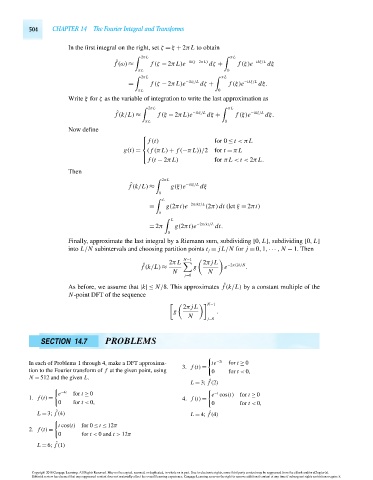Page 524 - Advanced engineering mathematics
P. 524
504 CHAPTER 14 The Fourier Integral and Transforms
In the first integral on the right, set ζ = ξ + 2π L to obtain
2π L π L
ˆ
f (ω) ≈ f (ζ − 2π L)e −ik(ζ−2π L) dζ + f (ξ)e −ikξ/L dξ
π L 0
2π L π L
= f (ζ − 2π L)e −ikζ/L dζ + f (ξ)e −ikξ/L dξ.
π L 0
Write ξ for ζ as the variable of integration to write the last approximation as
2π L π L
ˆ
f (k/L) ≈ f (ξ − 2π L)e −ikξ/L dξ + f (ξ)e −ikξ/L dξ.
π L 0
Now define
⎧
⎪ f (t) for 0 ≤ t <π L
⎨
g(t) = ( f (π L) + f (−π L))/2for t = π L
⎪
f (t − 2π L) for π L < t < 2π L.
⎩
Then
2π L
ˆ
f (k/L) ≈ g(ξ)e −ikξ/L dξ
0
L
= g(2πt)e −2πikt/L (2π)dt (let ξ = 2πt)
0
L
= 2π g(2πt)e −2πikt/L dt.
0
Finally, approximate the last integral by a Riemann sum, subdividing [0, L], subdividing [0, L]
into L/N subintervals and choosing partition points t j = jL/N for j = 0,1,··· , N − 1. Then
2π L 2π jL
N−1
ˆ −2πijk/N
f (k/L) ≈ g e .
N N
j=0
As before, we assume that |k|≤ N/8. This approximates f (k/L) by a constant multiple of the
ˆ
N-point DFT of the sequence
N−1
2π jL
g .
N
j=0
SECTION 14.7 PROBLEMS
In each of Problems 1 through 4, make a DFT approxima- te −2t for t ≥ 0
3. f (t) =
tion to the Fourier transform of f at the given point, using 0 for t < 0,
N = 512 and the given L.
L = 3; ˆ f (2)
e −4t for t ≥ 0 e cos(t) for t ≥ 0
−t
1. f (t) = 4. f (t) =
0 for t < 0, 0 for t < 0,
L = 3; ˆ f (4) L = 4; ˆ f (4)
t cos(t) for 0 ≤ t ≤ 12π
2. f (t) =
0 for t < 0and t > 12π
L = 6; ˆ f (1)
Copyright 2010 Cengage Learning. All Rights Reserved. May not be copied, scanned, or duplicated, in whole or in part. Due to electronic rights, some third party content may be suppressed from the eBook and/or eChapter(s).
Editorial review has deemed that any suppressed content does not materially affect the overall learning experience. Cengage Learning reserves the right to remove additional content at any time if subsequent rights restrictions require it.
October 14, 2010 16:43 THM/NEIL Page-504 27410_14_ch14_p465-504

